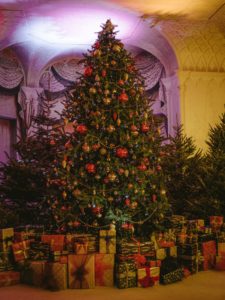
Do your eyes light up when you spot a faded green and white box of vintage Shiny Brite ornaments? Or, do you imagine a fresh, new look for your Christmas tree each year? No matter what your tree-decorating style, you may wonder where this crazy tradition of filling up a tree with fragile Christmas ornaments comes from.
Earliest Ornaments
As with many American Christmas traditions, holiday ornaments have origins in early modern Germany, in the 1600s. Many parts of Europe had adorned their homes with evergreen boughs for centuries, symbolizing eternal life and rebirth.
By medieval times, this tradition expanded in western parts of Germany to include bringing an entire evergreen tree into the home on Christmas Eve in celebration of the Feast Day of Adam and Eve. This household tree represented the “Paradise Tree” used in medieval plays performed on this feast day, which were often decorated primarily with apples. Some early records also mention decorations such as gingerbread, tinsel, wafers, straw, thread, and nuts.
Glass Ornaments
Natural and handmade ornaments were popular and inexpensive tree ornaments, readily available to many families. Fancier handmade ornaments might be cut from paper or lace. Even tinsel, made with real silver, had been used to decorate some trees.
By the mid-1800s, artisans in Germany developed techniques to hand-blow glass into molds to create the glass ornaments we know today. Too fragile to travel across the ocean with most immigrant families, the ornaments stayed behind, but the traditions came along with German settlers.
Victorian Christmas Ornaments
Between the Industrial Revolution and the elaborate fashion of the Victorian era, Christmas ornaments fully established themselves in the style we know today.
Decorated Christmas trees had been displayed in British palaces at least as early as the reign of George III, and with successive rulers of German heritage on the throne, the tradition persisted.
Victoria grew up with Christmas trees adorning her royal homes, and her husband, Prince Albert, even imported trees from Germany and decorated them with toys, gifts, and baubles. When an engraving of the royal family was published in a London newspaper, showing them admiring a lavishly decorated tree, the popular queen’s tradition quickly spread. The image was reprinted in publications on both sides of the Atlantic and fashionable families added decorated Christmas trees to their holiday decor.
19th & 20th Century Ornaments
Within decades of Queen Victoria’s famous scene, Christmas ornaments were being exported in quantity from Germany. In the 1880s, F. W. Woolworth imported German glass ornaments to market in his hundreds of five-and-dime stores, bringing the beauty of these special ornaments in reach of a large portion of the U.S. population.
In the mid-20th century, ornament makers such as Shiny Brite took over production in the U.S., and these decorative ornaments became a popular and patriotic choice during the war years. Even during wartime when cardboard tops were used to save metal for the war effort, families still purchased glorious, colorful glass ornaments.
Modern Ornaments
Since the mid-20th century, ornament styles have exploded. Personalized ornaments abound, and there’s a specialty ornament for everything and everyone, from cocker spaniels, eggplants, and hockey players to wine-lovers, plumbers, and unicorns.
Whether you enjoy an elegant, sparkling Victorian-style tree, a rustic, natural one, a chic, modern look, or an eclectic mix of all of your family’s favorites and heirloom ornaments, your Christmas tree holds a special place in your holiday decor. Check out your favorite antique store for everything from vintage glass garlands and clip-on bird ornaments with spun glass tails to a big box of Shiny Brite ornaments or some retro ribbon-and-sequin styrofoam balls. The special ornaments you find today will be the favorites you unbox for years to come when the holidays roll around.